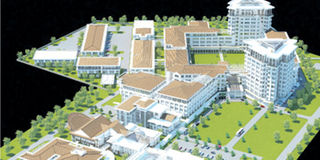Ministry disowns NHIF’s grand project

An artist’s impression of the NHIF hospital in Karen, Nairobi. The project has been mired in controversy. Photo/FILE
What you need to know:
- According to plans, the medical Centre will be in the main 10-storey tower. The tower will have an emergency unit, outpatient services, physiotherapy area, cancer treatment centre and 30 operating theatres.
Construction of controversial Sh22 billion National Hospital Insurance Fund (NHIF) hospital in Karen took a turn for the worse after top ministry officials disowned it.
According to documents seen by the Saturday Nation, the officials disowned the project in a meeting chaired by then Finance permanent secretary Joseph Kinyua in March.
The move has provoked NHIF Chief Executive Officer Simeon Kirgotty to request for direction from Health Cabinet Secretary, James Macharia in a letter of June 10.
The meeting between NHIF Board and Public Private Partnership Secretariat was scuttled after the ministry officials linked the project to a minister in the previous government.
In the letter, Mr Kirgotty wonders why the ministry committed itself to construct the proposed Karen Medical Centre of Excellence after NHIF funded the feasibility study of the project.
“The Ministry of Medical Services identified the envisaged Resource Centre as one of the flagship projects of Vision 2030. The communication from the ministry indicated that the project would be financed through credit from the Development Bank of China, in partnership with the Development Bank of Kenya,” says Kirgotty in the letter.
When complete, the project will have a medical centre, a training institute and an administrative building.
According to plans, the medical Centre will be in the main 10-storey tower. The tower will have an emergency unit, outpatient services, physiotherapy area, cancer treatment centre and 30 operating theatres.
It will also have 10 X-ray rooms, 26 ICU beds, 12 High Dependency Unit beds, Dialysis centre and 815 beds for inpatient wards.
It is expected that the Medical Centre will ease congestion experienced at Kenyatta National Hospital and the Moi Teaching and Referral hospital in Eldoret. It will also relieve hundreds of Kenyans who travel abroad seeking specialised medical attention.
In the letter, Mr Kirgotty gives the history of the project which dates back 2002, when the National Rainbow Coalition assumed office. The ministry instructed NHIF board to drive the project.
“The board commissioned consultants to prepare a detailed concept paper. The board submitted a background concept paper and feasibility study to the Treasury for approval,” writes Mr Kirgotty.
He says the board has lost funds paying pending bills after the ministry asked the consultants to revise drawings of the original plan.
The project has had a troubled past. Initially, the projected budget was Sh4 billion before it shot to Sh22 billion after the design was revised.
In 2008, the Cabinet put on hold the project after disagreeing on whether NHIF should commit the insurance money to construct a hospital. The move was being pushed by the ODM brigade in the Cabinet but it met resistance from their PNU counterparts.
According to a memo presented by then minister of Health Anyang’ Nyong’o, the Cabinet was to approve the establishment of the high level national and regional medical and training centre.
“A collaborative approach will be put in place so that Kenyatta National Hospital and the Resource Centre will complement each other in training and specialised healthcare,” the memo dated October 7, 2008 states.
Among the specialised services planned was:
^ Diagnostic services in the fields of medical imaging, radio and chemotherapy, pathology and analytical diagnostic laboratories.
^ Specialised treatment centre offering services in dialysis and kidney transplant, specialised cancer diagnosis and bone marrow transplants.
^ Accredited level 1 Trauma Centre to handle complex emergencies due to road, traffic and other injuries.
^ Geriatric and terminal care centre to handle the aging population and especially terminally ill patients.
^ Laboratories to give forensic research back-up to crime fighting departments in Kenya and neighbouring countries.




